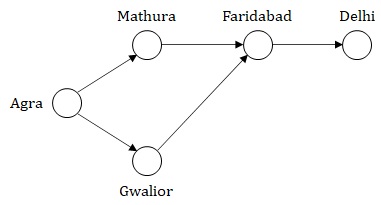CRE 1 - Routes & Network | DI - Routes & Networks
Join our Telegram Channel for CAT/MBA Preparation.
Answer the next 3 questions based on the information given below:
The following diagram shows the pipelines carrying material from one location to another. Each location has a demand for material. The demand at Mathura is 800, at Faridabad is 800, at Delhi is 1,400, and at Gwalior is 400. Each arrow indicates the direction of material flow through the pipeline. The flow from Mathura to Faridabad is 600. The quantity of material flow is such that the demands at all these locations are exactly met. The capacity of each pipeline is 2,000.

The quantity moved from Agra to Gwalior is
- (a)
400
- (b)
1600
- (c)
1400
- (d)
2000
Answer: Option D
Workspace:
What is the free capacity available in the Agra-Gwalior pipeline?
- (a)
600
- (b)
400
- (c)
200
- (d)
0
Answer: Option D
Workspace:
The free capacity available at the Agra-Mathura pipeline is
- (a)
0
- (b)
400
- (c)
200
- (d)
600
Answer: Option D
Workspace:
Answer the next 2 questions based on the information given below:
Natural gas once extracted from a source is purified for commercial use at natural gas plants. From gas plants it is pumped to various destinations through pipelines. There are pumping stations, at intermediate places to maintain recommended pressure in the pipelines. The pumping stations do not produce or process any natural gas. They pump out exactly the quantity they receive from plants or other pumping stations.
The following figure depicts a network gas pipelines. The circles denote the locations of gas plants, pumping stations or cities with big demand for natural gas. One location can be only one of these three. The numbers on the arrows are the capacities (in appropriate units) of the pipeline that carry gas in the direction of the arrow. Currently the demand supply situation is such that the capacity utilization of the pipelines is very close to 100%.

For which two cities it can be safely concluded that they have natural gas plants?
- (a)
M and P
- (b)
M and O
- (c)
P and N
- (d)
M and N
Answer: Option A
Workspace:
What is the maximum quantity of natural gas that can be transported from M to R?
- (a)
11 units
- (b)
7 units
- (c)
9 untis
- (d)
6 units
Answer: Option D
Workspace:
Eight cities A, B, C, D, E, F, G and H are connected with one-way roads R1, R2, R3, R4, R5 and R6 in the following manner:
- R1 leads from A to C via B;
- R2 leads from C to D and then via B to F;
- R3 leads from D to A and then via E to H;
- R4 leads from F to B via G;
- R5 leads from G to D; and
- R6 leads from F to H.
The minimum number of road segments that have to be blocked in order to make all traffic form B to D impossible is
- (a)
5
- (b)
4
- (c)
3
- (d)
2
- (e)
1
Answer: Option D
Workspace:
Feedback
Help us build a Free and Comprehensive Preparation portal for various competitive exams by providing us your valuable feedback about Apti4All and how it can be improved.
 Solution
Solution Discuss
Discuss Report
Report